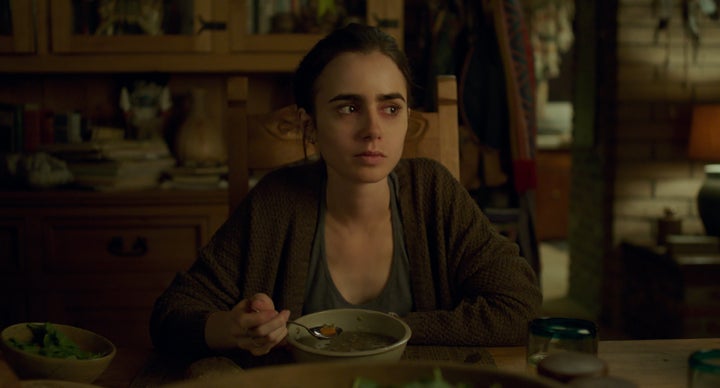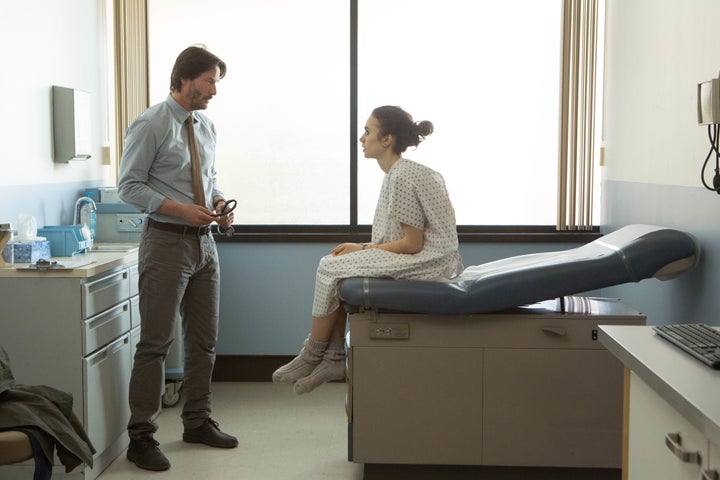
Chances are you’ve devoured a program with Marti Noxon’s imprint on it. She was one of the principal forces behind “Buffy the Vampire Slayer,” after which she co-created “Point Pleasant” and wrote episodes of “Grey’s Anatomy,” “Private Practice,” “Mad Men” and “Glee.” Her latest creations include “UnREAL,” “Girlfriends’ Guide to Divorce,” the forthcoming HBO adaptation of Gillian Flynn’s “Sharp Objects” and the new Netflix movie “To the Bone,” which premiered July 14.
“To the Bone” is a personal project for the 52-year-old Noxon, who channeled her own struggles with anorexia to tell the story of a sardonic 20-something (Lily Collins) whose uptight stepmother (Carrie Preston) encourages her to move into a home for young adults with eating disorders. There, she works with a frank doctor (Keanu Reeves) who employs radical therapy strategies, and she meets an artistic love interest (Alex Sharp) with a penchant for grand gestures.
After male studio executives showed little interest in the movie, Noxon found the backing of female producers. Following its well-received Sundance premiere in January, “To the Bone” sold to Netflix for a steep $8 million. We hopped on the phone with Noxon last week to discuss the film and her career.

Given your own experiences with anorexia, what did you hope to convey with this movie?
Any time you make a movie about a disorder of any kind, it has the potential to be all one thing, or to be maudlin. I really hoped with this project that we’d have variation and we’d really show a person who also happens to have a disorder, not a movie about a disease.
After years of working in television, this is your directorial debut. Did you ever imagine it as a series instead?
I never did think of it as a TV show because it was so personal to me. I had gone through it. It felt to me like a story that wanted to have a beginning, a middle and an end. It’s a difficult topic; it’s not necessarily one that you want to live in forever.
Other than the scripts you were hired to write, like “Fright Night” and “I Am Number Four,” have you tried to get your own moves off the ground before?
I had another feature that I wrote — I’ve always joked that I had one project for them and one for me. The one for me is something that I write just for myself. With the same producer, Julie Lynn, I had developed a script that I wrote just for me. We actually attached Susan Sarandon to star in it, but it just never got off the ground. So when I wrote this and brought it to Julie and asked her if she thought it was a movie, she wrote me back an email — she also produced the movie “Wit,” and she said she thought it was not unlike it in its DNA, and she felt really strongly that we needed to make it. It very much comes from an authentic place that I care about.
Maybe you don’t trace the through-lines in your work this explicitly, but a lot of your stories deal with characters battling monsters, literal and figurative: the vampires in “Buffy,” the bullying and manipulation in “UnREAL,” divorce in “Girlfriends’ Guide to Divorce,” and now anorexia in “To the Bone.”
I absolutely think one thing I learned from [“Buffy” creator Joss Whedon] early on was that leaning into genre conventions to tell harder stories is a great way to Trojan-horse-in other content. For me, “Girlfriends’ Guide” was a romantic comedy, but we brought in a lot of content about sexual politics, feminist issues and lots of things that are really important to me, but in a pretty package. It’s issues with really nice heels. And with this one, I think the YA genre became a really great container for me because I felt it was dealing with issues that were character-driven and there was room for humor there and a little bit of romance. I invented this character who was at the home with Lily’s character, and they have a kind of odd romance. By bringing in a few more conventional things, I was able to tell a pretty challenging story. So I’m absolutely still using the lessons I learned on “Buffy” — it’s just that as I’m getting a little older and honing in on my voice, I don’t need the monster costume.

You created a character who is wry and clipped, and the tone of “To the Bone” is often relatively light. Did you start with a heavier script and then mine for humor?
No, I think that is the way I have learned to write. My first draft of this was not that far from what we ended up shooting. I’ve been thinking about it for a long time, and obviously there were some rewrites, but a lot of it is what you see. Because some it actually happened to me, it was the greatest chance to go back into my past and say, “If I had been really cool or known the right thing to say, I would have done that.” Lily got to play the cooler, quicker version of me when I was that age. The humor was a goal, and I wanted to bring it in at the beginning. The very first scene in the recovery home where she shows her collage, I wanted to immediately disarm people about what their expectations were going to be.
Having written for “Buffy” since Season 2 and then been the showrunner during its sixth and seventh seasons, how did you feel about the glowing attention it got this year for its 20th anniversary?
I’ll be honest: I had a real deep-seated fear that “Buffy” was going to be my peak. It was such a beautiful experience. It was such a fully realized show. I had such a great relationship with Joss. There were so many things that felt once-in-a-lifetime, and I kind of thought, “This is my first job and it may be my last job.” It was twofold, me being so grateful that it still resonates with people. In this day and age, shows can live in perpetuity. But on the other hand I was really moved because it was a beginning for me, not an end. I’m still using the lessons I learned on that show to this day. I’ve grown and changed, and I’m still making television and movies that I feel really proud of. I felt like, wow, 20 years is a short time — it went by really fast. I’m also amazed to see that so many of the writers and creative people involved with that show have gone on to do really remarkable work. It was touching and very moving.
Now that you’re creating your own shows and directing movies, are you less inclined to write for other people’s shows, the way you did with “Private Practice,” “Mad Men” and “Glee”?
Gosh, it’s funny that you ask that because there are certain shows that I would love to try my hand at.
Like what?
Like everbody, I’m addicted to “The Handmaid’s Tale.” But I also love “Kimmy Schmidt” — I’m addicted to that. There are certain shows or people that I would love to work with. One of the greatest things about our business is that if you get to fan out on people you might actually get to meet. “Silicon Valley” is another show that I love. Kumail Nanjiani and I are sort of on the circuit at the same time with sick-people movies. [Editor’s note: Nanjiani co-wrote and stars in “The Big Sick,” which opens in wide release this weekend.] I reached out to him, and we’ve chatted back and forth. He’s one of my favorite actors and comedians around, so I’d love to just work with certain people. This was one of the first times I got to make something where the final decision about what went in or what didn’t go in was up to me. There were notes and there was feedback, but ultimately it was my decision. You live for that, and as scary as that was, it was pretty incredible. It’s hard to want to go back to working by committee.
“To the Bone” is now streaming on Netflix.
This interview has been edited and condensed for clarity.
